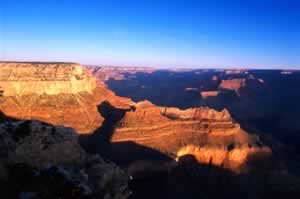The Mountains are Singing:
Beauty and Devotion among the Red Rocks

Sedona, Arizona
by Mark Ogilbee and Jana Riess
Show Page: prev | 1 2 3 4 | next
To most people, Sedona is most closely associated with believers in New Age spirituality. One such believer, a young man named Peter, took a year off between high school and college to make a pilgrimage to Sedona. He journeyed from Massachusetts with a friend to experience the beauty of the rocks, where he and his friend hung out, illegally hawking crystals and handmade trinkets to tourists taking in the view.
(“Like, if we get caught selling this stuff, it's a five hundred dollar fine,” he said.) At night, they unfurled their sleeping bags and slept out under the stars. One evening as he closed up his crystal “shop,” Peter pointed out across the valley and said, “See those red rocks over there? Looking at that big red rock formation does something to you. It's stimulating withoutbeing jarring or tense. It heightens your awareness.”
When we journey forth on pilgrimage, we expect to encounter something new. We open our senses and become more willing to experience the unknown or the unusual; we have a heightened willingness to touch—and be touched by—the spiritual. In colorful language Peter, in describing the effect of the rocks across the valley, was describing what forest-dwellers and desert-wanderers of many faiths have recognized from the beginning: that we are not separate from creation; that the outer, physical landscape can help us chart the inner, spiritual one; that the land itself harbors a unique power to awaken and inspire our souls.
And Peter was right. The various shades of brown and red in the rocks across the valley seemed to be fluid; their colors had become richer and more nuanced with the fading daylight and deepening of blue evening skies. Through a trick of perspective, or of the limitations of the human eye, or the influence of some kind of strange energy, the rocks across the valley seemed to be distant and, simultaneously, close. You felt that if you extended your arm, somehow your fingers would reach all the way over there and touch the lovely rocks, still warm from sunshine. This had a calming effect; you felt somehow less like an observer looking at mountains, and more like you, too, were a part of the landscape. Beholding the rocks altered your perspective.
Peter had an elaborate and surprisingly eloquent system of belief built up around experiences such as this of Sedona. “Rocks, animals, people—we're all just bodies of energy, resonating at different frequencies. So those mountains over there aren't just big piles of rock with trees on top—they're emanating a lot of energy that's vibrating just under the surface, at different frequencies. One way of putting it is, ‘The mountains are singing.'”
Peter had also come to explore the vortexes famously associated with Sedona. These vortexes (locals seem to prefer “vortexes” over “vortices”) are some half-dozen nodes of spiritual energy that became popularized in the 1980s. Just as the origins of older, more traditional pilgrimage sites are sometimes attested to only by sketchy tales and dubious legends, precisely how Sedona's vortexes came to be recognized—or even how many there are or what exactly they do—is hard to pin down. Walk into almost any shop or convenience store in town and you'll find books and pamphlets galore on the topic, often differing on the details.
Some even weave elaborate cosmologies with regard to these vortexes. Others state more simply that “a vortex is a place in nature where the Earth is exceptionally healthy” and that “the energy of a vortex acts as an amplifier. . . . The energy will amplify—or magnify—what we bring to it, whether on a physical, mental, emotional, or spiritual level.” What all theories agree on is that vortexes are places of concentrated positive energies that tend to encourage feelings of peace and positivity.
It might be easy to write off the idea of vortexes as so much hocus-pocus, but it's true that while you're in Sedona, you are likely to find yourself (perhaps even despite your expectations) feeling lighter somehow, less burdened, friendlier. And, if nothing else, the concept of vortexes provides a handy if somewhat mysterious explanation for the very real experience of heightened spiritual power in a particular location—a convenient way for the pilgrim to remember, describe, and convey the mystery of the experience itself. Using an unlikely image to describe a spiritual reality is an ancient impulse: “vortexes” mark nodes of spiritual energy in Sedona the same way, perhaps, that a “burning bush” marked Moses' holy ground.
What's more, the idea of vortexes aren't the province of New Age believers alone—another mark of Americans' distinct willingness to absorb elements of diverse belief systems into their own. One man who identified himself as a devout Christian didn't see any conflict between the notion of vortexes and his own faith at all. “I was up there praying to Jesus,” he said. “If there's a vortex, then it's part of the world that God created, so to me, it's a holy site. It's a holy site for everyone.” Show Page: prev | 1 2 3 4 | next
Copyright ©2006 Mark Ogilbee and Jana Riess
Reprinted from AMERICAN PILIGRIMAGE: ELEVEN SACRED JOURNEYS AND SPIRITUAL DESTINATIONS published by Paraclete Press, May 2006.

To purchase a copy of AMERICAN PILGRIMAGE, visit amazon.com. This link is provided as a service to explorefaith visitors and registered users.
|




